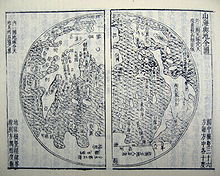This articleneeds additional citations forverification.(February 2016) |
Sancai Tuhui(Chinese:Tam tài đồ hội,san-TS'EYETOO-khwey), compiled by Wang Qi (Chinese:Vương kỳ) and his son Wang Siyi (Vương tư nghĩa), is a Chineseleishuencyclopedia, completed in 1607 and published in 1609 during the lateMing dynasty,featuring illustrations of subjects in the three worlds of heaven, earth, and humanity. The work contains a large number of posthumous and contemporary depictions ofChinese emperors.
| Sancai Tuhui | |||||||||||||||
|---|---|---|---|---|---|---|---|---|---|---|---|---|---|---|---|
 The world mapShanhai Yudi QuantuinSancai Tuhui | |||||||||||||||
| Traditional Chinese | Tam tàiĐồHội | ||||||||||||||
| Simplified Chinese | Tam tài đồ hội | ||||||||||||||
| Literal meaning | collection of illustrations of the three realms | ||||||||||||||
| |||||||||||||||
Title
editThe title of this encyclopedia has been variously translated into English as "Illustrations of the Three Powers",[1]"Collected Illustrations of the Three Realms", "Pictorial Compendium of the Three Powers", and others; in the original title, "Sancai" (Tam tài) refers to the three realms of "heaven, earth, and man", and "Tuhui" (Đồ hội) means "collection of illustrations".
Description
editThis encyclopedia is organized into 106 chapters in 14 categories (astronomy,geography,biographies,history,biology,and such), with text and illustrations for the articles. Reproductions of this encyclopedia are still in print in China.
While it contains some inaccurate or mythological articles (for example, the articles on thehorseshoe craband thecrane), it also distinguished itself from the common "everyday encyclopedias" (Nhật dụng loại thư,riyong leishu) at that time by being accurate in some other articles (for example, accurate depictions of theJapanese,KoreanandVietnamesepeople'sclothing,and a very accurateworld map(theShanhai Yudi Quantu).
See also
edit- Song Yingxing
- Wakan Sansai Zue- A Japanese encyclopedia inspired by the ChineseSancai Tuhui
References
editExternal links
edit- (in Chinese)http://www.ncl.edu.tw/rarebook/oldcol.htm
- (in Chinese)https://web.archive.org/web/20050316001242/http://www.lib.ntu.edu.tw/dbs/dbs/ref/BOOKchin.htm
- (in Chinese)https://archive.today/20031217211032/http://www.xhlib.net/xinshu02.htm(World Maps in the Ming Dynasty from the Shanghai Xuhui District Library)
- (in English)http://www.ihp.sinica.edu.tw/~ihpcamp/pdf/92year/wang-cheng-hua-2.pdf- Wang, Cheng-hua.""Art and Daily Life: Knowledge and Social Space in Late-MingRiyong Leishu""(PDF).(207KiB),pp. 8–9.
- (in Chinese)http://horseshoecrab.sinica.edu.tw/15th.htm
- (in Chinese)https://web.archive.org/web/20051128075412/http://www.fhk.gov.tw/fhkbook/hist/hist.asp-sq_no=45.htm
- (in English)http://www.rice.edu//fondren/erc/projects/jingban/(A map from the Chinese encyclopedia)